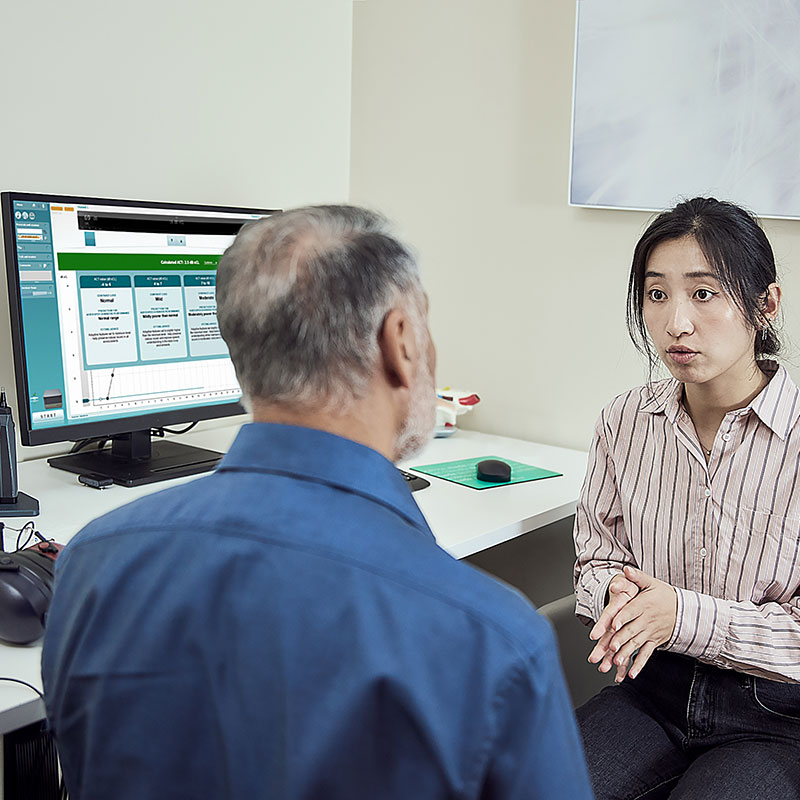Trends in hearing aid fitting
The hearing aid fitting landscape is changing, and likewise the trends we see in this discipline. In some parts of the world, the established private sector is under pressure from over-the-counter (OTC) hearing aids and personal sound amplification products (PSAPs). Countries with large public sectors are under pressure to cut costs and to increase capacity necessitated by demographic shifts. Finally, the developing world is facing the bottleneck of a shortage of trained audiologists.
How can we overcome these challenges?
Automated testing
In part, the two latter challenges could be solved by automated testing.
Everything we can do to reliably automate screening and diagnostic tests will help to free up the precious audiological resources. This can be done in a range of ways, going from rule-based approaches from knowledge and evidence such as IA-AMTAS, to machine-learning based approaches that eventually can assist or possibly even replace the diagnostic evaluation of humans.
Read more: A Deep Learning Approach for Detecting Otitis Media from Wideband Tympanometry Measurements
Depending on the setting, the time saved could be used to either increase the capacity of the system, or to allow audiologists to devote more of their time to their areas of specialty: advanced diagnostics, personalized hearing aid fitting, and counseling.
Alternatives to medical-grade hearing aids
Regarding the first challenge, the initial wave of OTC instruments and PSAPs shows a large technological gap to medical-grade hearing aids, not to mention the lack of a hearing-care professional in the process of purchasing and fitting these alternatives.
This is also reflected in the purchasing habits among hearing-aid users. In a 2023 poll, the American Speech-Language-Hearing Association (ASHA) found that only 2% of American adults aged 40 and older have purchased OTC hearing aids, with 4% likely to purchase them in the next year.
Read more: OTC Hearing Aids Aren’t Attracting Buyers Yet
While technology is important in providing the foundation and the opportunities for a successful hearing aid fitting, what really makes the difference is the careful personalized fitting of the hearing aid and counseling the client about how to use the aid effectively.
Audible Contrast Threshold (ACT™) test
One way to ensure a personalized fitting is the ACT test, which is a new test researched and developed by the Interacoustics Research Unit (IRU) together with partners at the Technical University of Denmark and Oticon A/S (Figure 1).
Read more: The research behind ACT

ACT is a simple, fast, and language-independent test that quantifies an individual’s hearing-in-noise ability. It has several potential uses, such as when:
- Selecting hearing aids for the individual client.
- Managing the client’s expectations about life with hearing aids.
- Individualizing signal processing features such as noise reduction and beamforming.
Being able to fit hearing aids to the individual’s speech-in-noise needs should improve the first fits and lead to more people becoming happy hearing-aid users faster.
Real-ear measurement
Another way to ensure a personalized fitting is real-ear measurement, which has been around since the 1980s and is an objective measure of what a hearing aid is doing inside the ear canal. These measurements are essential to perform because the anatomy of the ear canal is unique to each person, which will impact the sound delivered to the ear canal. Real-ear measurement is the only way you can measure – and account for – these effects in the hearing-aid programming.
Key takeaways
Advances in technology and ongoing research in new technologies provide access to new hearing instruments and hearing-aid fitting solutions. But despite these advances, the human touch and human care remain vital in ensuring satisfied hearing-aid users.

Subscribe
By signing up, I accept to receive newsletter e-mails from Interacoustics. I can withdraw my consent at any time by using the ‘unsubscribe’-function included in each e-mail.
Click here and read our privacy notice, if you want to know more about how we treat and protect your personal data.
Similar Topic
Get audiological tips
Subscribe for audiological tips and be the first to know about new products, features and training.
By signing up, I accept to receive newsletter e-mails from Interacoustics. I can withdraw my consent at any time by using the ‘unsubscribe’-function included in each e-mail.
Click here and read our privacy notice, if you want to know more about how we treat and protect your personal data.
